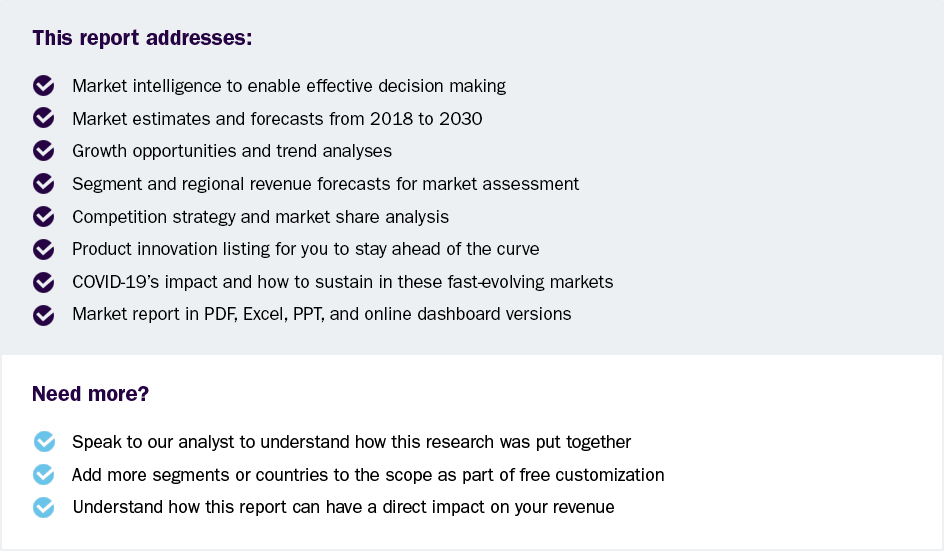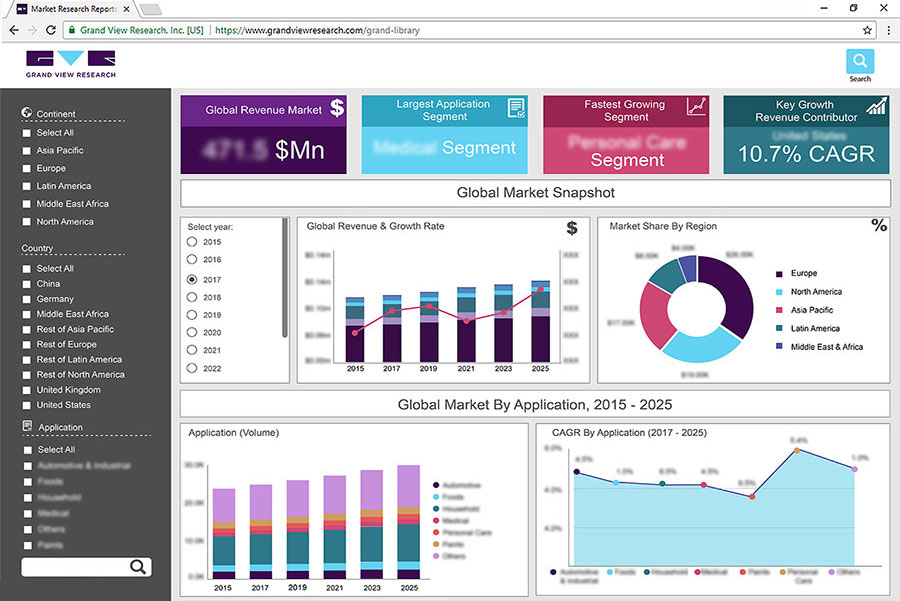
Modular Construction Market Size, Share & Trends Analysis Report By Type (Relocatable, Permanent), By Material (Wood, Steel, Concrete), By Application (Residential, Commercial), By Module (Wood, Steel, Concrete), By Region, And Segment Forecasts, 2025 - 2030
- Report ID: GVR-3-68038-561-8
- Number of Report Pages: 100
- Format: PDF, Horizon Databook
- Historical Range: 2018 - 2023
- Forecast Period: 2025 - 2030
- Industry: Advanced Materials
Modular Construction Market Size & Trends
The global modular construction market size was estimated at USD 103.55 billion in 2024 and is projected to grow at a CAGR of 7.9% from 2025 to 2030. This growth is attributed to growing demand for affordable housing coupled with increasing investment in the development of healthcare and commercial infrastructure around the globe. Off-site building activities in urban regions are also growing, which is further driving growth of modular building market. Off-site building is not affected by weather conditions as they are manufactured within closed factories using advanced machinery, thereby, optimizing the construction time and providing high-quality Types. The benefits of off-site building make modular building cost-effective and contribute to less site-generated waste.
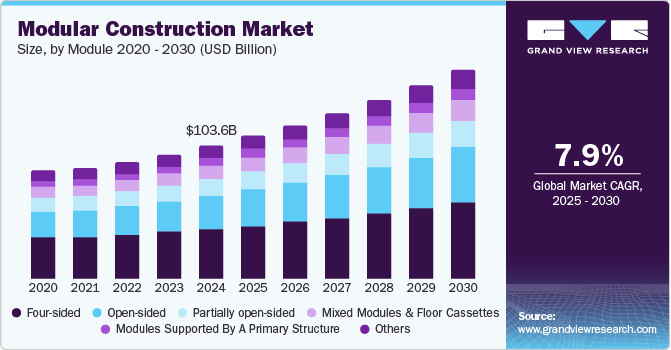
Rapid urbanization and industrialization are expected to increase the number of new projects, primarily in commercial and industrial sectors. This is likely to fuel the growth of the construction industry across the globe. Increasing technological advancements in building industry coupled with the advantages provided by modular building techniques such as reduced building schedule, reduced cost, greater flexibility, reuse, and less material waste are contributing to increasing Type demand.
Modular building enables industries to customize their designs and utilize the latest innovations in style and functionality. Before the development of modular construction, industries were compelled to spend countless man-hours on planning and designing, while actual construction took months or years to complete. Modular building takes the guesswork out of the planning stages and simplifies building to a large extent, reducing time from conception to completion by months or more.
Market Concentration & Characteristics
Market growth is high, and the pace of this industry growth is accelerating. Modular construction industry is characterized by a high degree of innovation owing to rapid technological advancements. This industry for is characterized by developments in technology to produce advanced Types used in different applications. Advancements in extended 3D analysis of building systems (ETABS) and Revit software/3D max have resulted in the development of increased penetration of modular building in different applications. Extended 3D Analysis of Building Systems (ETABS) is an engineering software that carries out the design and structural analysis of buildings. It offers 3D object modeling and visualizing tools. This software also offers insightful reports, graphic displays, and schematic drawings to enable users to decipher design results and understand the building structure analysis easily. ETABS has sophisticated and comprehensive design capabilities for a broad range of materials and possesses fast linear and nonlinear analytical power.
Modular construction industry is also characterized by a high level of merger and acquisition (M&A) activity by leading players. This is due to several factors, including shifting focus towards expansion of Typeion capabilities and strengthening their position in this industry.
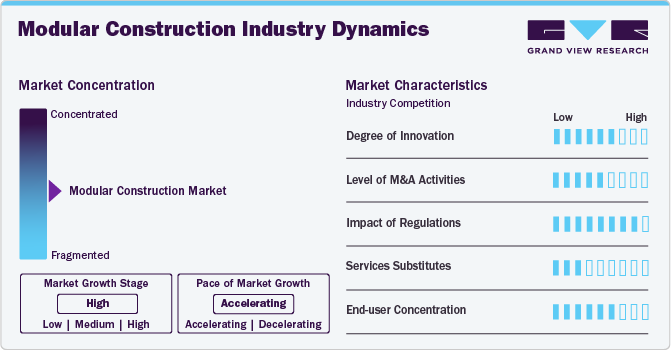
Various associations and regulatory bodies across the globe have set regulations with regard to the designing, manufacturing, transportation, and erection of pre-engineered and modular buildings. ASTM standards define various parameters such as dimensions and tolerance level of components used in pre-engineered buildings. Manufacturing companies must adhere to the standards set by various associations such as MBMA, AISC, AISI, and AWS for modular construction structures during their entire manufacturing process.
End-user concentration is a significant factor in this industry as there are a number of end-user industries that are driving demand for modular construction. The demand for modular building is growing among the end-user industries on account of growing awareness regarding benefits of offsite construction. The manufacturers of modular construction offer final Types to end users in the residential, industrial, commercial, educational, and healthcare sectors. The demand for modular construction is rising from end users as it helps reduce the building time, cost, and material waste generated. As modular construction building units are manufactured at the worksites and simply assembled & installed by the end-users at the project site, this further helps to speed up the building process, their preference among the end-users is largely increasing.
Type Insights
The permanent segment led the modular construction industry and accounted for a revenue share of 64.45% in 2024. Permanent modular construction offers enhanced design flexibility and customization, enabling the creation of visually appealing and architecturally diverse buildings. Its robust quality control ensures consistent safety, durability, and high standards, making it a preferred option for developers, architects, and clients seeking reliable, long-lasting solutions. These advantages position permanent modular construction as a leader in the modular construction industry, catering to permanent and relocatable building needs with a growing demand for efficiency and resilience.
The relocatable modular construction segment is expected to grow significantly at a CAGR of 7.3% over the forecast period. Temporary housing for emergency and relief efforts has become increasingly popular. These structures are designed to be easily relocated and adapted to different sites. During the urgent need for housing for disadvantaged communities, relocatable construction models offer an ideal solution, helping to address both time and budget limitations efficiently. The demand for temporary office spaces, storage, and housing in large construction projects has driven their increased need. These structures offer a practical and flexible solution to meet the short-term needs of such projects.
Material Insights
The steel segment dominated the market and accounted for a revenue share of 41.3% in 2024. The material comes in various forms, including H-type beams, columns, angles, I-beams, and T-shapes. It boasts remarkable mechanical and chemical properties such as high strength, durability, ductility, ease of fabrication, resistance to seismic forces, and rapid assembly. It is commonly used as a reinforcing agent in concrete to offset its lower tensile strength. Pre-engineered steel structures are frequently employed in large, open spaces, particularly for commercial and industrial applications. Steel frames are lighter than many other wall materials, making it easier to crane and transport building components efficiently, which minimizes disruption to the surrounding area and helps lower costs.
The concrete segment in the market is estimated to grow at the fastest CAGR of 8.0% over the forecast period. Concrete’s durability and strength make it ideal for modular buildings, ensuring long-term structural integrity and resistance to weather conditions. Its natural fire resistance enhances safety, benefiting both residential and commercial projects. Concrete also improves energy efficiency by providing better insulation and lowering heating and cooling costs. Minimal maintenance requirements further reduce long-term expenses. With its wide availability and cost-effectiveness, concrete is preferred in modular construction, enabling faster, more affordable project completions while meeting the growing demand for sustainable building solutions.
Module Insights
The four-sided segment dominated the market and accounted for a revenue share of 37.46% in 2024. The growing demand for affordable and prefabricated housing solutions plays a crucial role in the expansion of the four-sided module segment. With rapid urbanization and housing shortages in various regions, governments and private developers are increasingly turning to modular construction to meet demand. The ability to construct multi-story residential buildings quickly and efficiently makes four-sided modules a preferred choice in the industry.
The open-sided segment in the modular construction industry is estimated to grow at the fastest CAGR of 9.0% over the forecast period, driven by increasing demand for flexible and customizable building solutions. Open-sided modules provide enhanced design adaptability, allowing for larger open spaces without internal load-bearing walls. This makes them particularly suitable for applications such as hotels, commercial buildings, and healthcare facilities, where spacious interiors and seamless connectivity between modules are essential. The ability to integrate multiple open-sided modules enables architects and developers to achieve more complex designs while maintaining the benefits of off-site construction.
Application Insights
Residential modular construction dominated the market and accounted for a revenue share of 53.2% in 2024. Modular construction offers an innovative approach to creating visually appealing buildings with an emphasis on sustainability and design. It enables quick construction, accommodates complex design challenges, and allows for the creation of distinctive, customizable homes that meet the specific needs of communities. Rising global population and urbanization have heightened the need for housing, especially in crowded urban areas. Modular construction provides an efficient, cost-effective solution, reducing build times and costs. Its versatility offers various customizable residential designs, meeting diverse housing needs and preferences in rapidly growing cities.
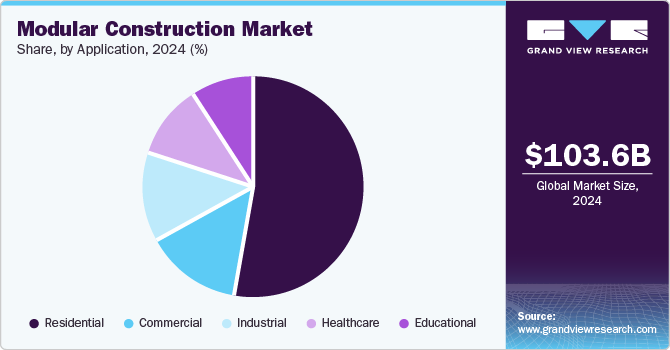
The commercial sector in the market is expected to grow significantly at a CAGR of 7.7% over the forecast period. The recovering economic situations in key markets such as the UK, the U.S., and Asia are expected to generate robust demand for commercial spaces such as offices, showrooms, and hotels, thus leading to increased commercial building activities. From portable commercial buildings to modular retail stores, modular construction holds the potential to disrupt industry. These buildings are constructed by the International Building Code (IBC). The dynamism of modular construction makes it an ideal option for use across different commercial sectors such as offices, public restrooms & bathrooms, restaurants, and diners.
Regional Insights
Europe region dominated the market and accounted for a 46.19% share in 2024 and is expected to continue its dominance over the forecast period. This is on account of high level of penetration in Germany, Finland, UK, and Sweden. Primary driving factor is expected to be the rising influx of migrants necessitating the development of temporary and permanent housing structures. Moreover, factors such as multiple investments and the implementation of advanced technologies are driving the modular construction market in Europe.

UK Modular Construction Market
In UK, modular construction is gaining popularity as a viable method of constructing affordable homes owing to various factors such as population growth and shortages in housing. The number of modular homes in the UK is increasing, and the country's top construction companies, investors, and developers are exploring modular housing solutions. As the UK government plans to construct approximately 300,000 new homes per year to address the challenges in the housing market, the modular building sector is expected to play a significant role.
North America Modular Construction Market Trends
The North America modular construction market held a substantial market share of 14.4% in 2024. Technological advancements such as Building Information Modeling (BIM), 3D printing, and automation have improved modular construction's efficiency, precision, and quality, making it more attractive to developers and investors. In urban centers such as New York and San Francisco, rising demand for affordable housing drives the adoption of modular solutions, offering faster, cost-effective alternatives. Modular buildings are also gaining popularity for disaster relief, providing scalable, quick solutions for housing and essential facilities.
Growth of modular construction sector in Canada is driven by increase in new education start-ups, office constructions, and new multifamily construction projects. Industrial workforce housing sector is one of the most important end-use markets for modular building sector in Canada. The modular industry provides temporary workforce housing solutions in remote areas where the energy sector is active.
Asia Pacific Modular Construction Market Trends
The Asia Pacific modular construction market is expected to grow at the fastest CAGR of 8.7% over the forecast period due to rising international investments in the region's infrastructural sector. The increasing demand for sustainable structures owing to growing environmental concerns and rising pollution rates is propelling the deployment of modular construction and contributing significantly to its growth. Asia-Pacific is a rapidly developing region, home to major emerging economies such as India and China, further driving the growth of modular construction.
Modular construction has gained traction in China in the last two decades owing to rapid economic development, rising labor costs, quality & affordability of homes, innovations in construction technologies, and promotion of national policies. Several electronic companies in China are working on advanced robotics and automation technologies that are being used in modular building industry.
Demand for modular building is growing rapidly in Singapore due to government policies of promoting construction sector, which is in line with the country’s vision of continuous increase of Typeivity in the construction industry. In Singapore, modular building technique is well-suited for implementation in urban and congested areas. As this construction process is delocalized off-site, it generates almost no nuisance in terms of sound, dust, or traffic. The installation process on-site takes only a few weeks, as compared to a few months for conventional in-site construction.
Saudi Arabia Modular Construction Market Trends
Saudi Arabia, which is one major contributors to Middle East and African economy, is adding more rail lines, investing in workforce, expanding shipping ports, and providing other incentives to gain attention of global and domestic suppliers. Thus, investment in the infrastructure sector of this region is likely to positively influence the market over the forecast period. For the development of megaprojects, adoption of advanced technologies to speed up this building process and reduce labor costs is increasing; therefore, modular construction industry is expected to grow over the forecast period.
Brazil Modular Construction Market Trends
Various new players entering the construction industry in Brazil are focusing on adopting advanced technology in this construction field to improve speed and quality of the construction. The rise in the adoption of advanced technologies by new players in the construction industry is expected to boost the market over the forecast period.
Key Modular Construction Company Insights
Some of the key players operating in this industry include Sekisui House Ltd., Skanska and Lendlease Corporation
-
Sekisui House Ltd. designs, contracts, constructs, and supervises landscaping and exterior construction activities, along with cultivation, purchase, and sales of plants. This company operates through four business segments, namely, Built-to-order business, Supplied housing business, Development business, and Overseas business
-
Skanska is a construction and project development company focused on selected home markets in Nordic region, Poland, Czech Republic, Hungary, Europe, and the U.S. It operates through three business segments, namely construction, residential development, and commercial property development
-
Lendlease Corporation is a globally integrated real estate and investment group with core expertise in shaping cities and creating strong and connected communities. It operates through three business segments, namely development, construction, and investments.
Guerdon, LLC and Riko Hiše d.o.o are some of the emerging industry participants in this market.
-
Guerdon, LLC is engaged in the development of medium to large scale multi-story modular construction projects with a primary focus of using modular construction methods. It is specialized in modular experience building multifamily, hospitality, assisted living, student housing, and remote workforce housing projects.
-
Riko Hiše d.o.o develops wooden, eco-friendly, energy-efficient, and prefabricated buildings. The company designs each building exclusively according to the expectations and requirements of customers to meet their requests, needs, and lifestyles.
Key Modular Construction Companies:
The following are the leading companies in the modular construction market. These companies collectively hold the largest market share and dictate industry trends.
- Sekisui House Ltd.
- LAING O'ROURKE
- Red Sea International
- Skanska
- Bouygues Construction
- Premier Modular Limited
- LEUSBERG GmbH & Co KG
- DuBox
- Wernick Group
- CIMC Modular Building Systems Holdings Co., Ltd. (CIMC-MBS)
- Riko Hiše d.o.o
- Lendlease Corporation
- Modulaire Group
- Guerdon, LLC
- Hickory Group
View a comprehensive list of companies in the Modular Construction Market
Recent Developments
-
In January 2025, Sunbelt Modular Inc. acquired BRITCO Structures, USA (BUSA), a Texas-based modular building manufacturer specializing in complex commercial projects. BUSA, founded in 2011, complements Sunbelt's strategy of providing custom modular solutions. This acquisition enhances Sunbelt's national platform, expanding its government, education, healthcare, housing, and offerings. It marks Sunbelt's 11th acquisition, following its purchase by Littlejohn & Co. in 2024.
Modular Construction Market Report Scope
|
Report Attribute |
Details |
|
Market size value in 2025 |
USD 111.07 billion |
|
Revenue forecast in 2030 |
USD 162.42 billion |
|
Growth rate |
CAGR of 7.9% from 2025 to 2030 |
|
Base year for estimation |
2024 |
|
Historical data |
2018 - 2023 |
|
Forecast period |
2025 - 2030 |
|
Quantitative units |
Revenue in USD million/billion, and CAGR from 2025 to 2030 |
|
Report coverage |
Revenue forecast, company ranking, competitive landscape, growth factors, and trends |
|
Segments covered |
Type, material, application, module, region |
|
Regional scope |
North America; Europe; Asia Pacific; Middle East & Africa; Central & South America |
|
Country scope |
U.S.; Canada; Mexico; Germany; UK; Sweden; China; India; Japan; Singapore; Australia; Brazil; Saudi Arabia; UAE |
|
Key companies profiled |
Sekisui House Ltd.; LAING O'ROURKE; Red Sea International; Skanska; Bouygues Construction; Premier Modular Limited; LEUSBERG GmbH & Co KG; DuBox; Wernick Group; CIMC Modular Building Systems Holdings Co., Ltd. (CIMC-MBS); Riko Hiše d.o.o; Lendlease Corporation; Modulaire Group; Guerdon, LLC; Hickory Group |
|
Customization scope |
Free report customization (equivalent up to 8 analysts working days) with purchase. Addition or alteration to country, regional & segment scope. |
|
Pricing and purchase options |
Avail customized purchase options to meet your exact research needs. Explore purchase options |
Global Modular Construction Market Report Segmentation
This report forecasts revenue growth at regional, and country levels and provides an analysis of the latest industry trends in each of the sub-segments from 2018 to 2030. For this study, Grand View Research has segmented the global modular construction market report based on type, application, material, module, and region:
-
Type Outlook (Revenue, USD Million; 2018 - 2030)
-
Relocatable
-
Permanent
-
-
Material Outlook (Revenue, USD Million; 2018 - 2030)
-
Wood
-
Steel
-
Concrete
-
Others
-
-
Application Outlook (Revenue, USD Million; 2018 - 2030)
-
Residential
-
Commercial
-
Industrial
-
Healthcare
-
Educational
-
-
Module Outlook (Revenue, USD Million; 2018 - 2030)
-
Four-sided
-
Open-sided
-
Partially open-sided
-
Mixed modules & floor cassettes
-
Modules supported by a primary structure
-
Others
-
-
Regional Outlook (Revenue, USD Million; 2018 - 2030)
-
North America
-
U.S.
-
Canada
-
Mexico
-
-
Europe
-
Germany
-
UK
-
Sweden
-
-
Asia Pacific
-
China
-
India
-
Japan
-
Singapore
-
Australia
-
-
Central & South America
-
Brazil
-
-
Middle East & Africa
-
Saudi Arabia
-
UAE
-
-
Frequently Asked Questions About This Report
b. The global modular construction market size was estimated at USD 103.55 billion in 2024 and is expected to reach USD 111.07 billion in 2025.
b. The global modular construction market is expected to grow at a compound annual growth rate a CAGR of 7.9% from 2025 to 2030 to reach USD 162.42 billion by 2030.
b. The permanent modular construction accounted for the largest revenue share in 2024 owing to the increasing adaption of modular construction techniques in commercial construction activities.
b. Some key players operating in the modular construction market include Sekisui House Ltd., LAING O'ROURKE, Red Sea International, Skanska, Bouygues Construction, Premier Modular Limited, KLEUSBERG GmbH & Co KG, DuBox, Wernick Group, CIMC Modular Building Systems Holdings Co., Ltd. (CIMC-MBS), Riko Hiše d.o.o, Lendlease Corporation, Modulaire Group, Guerdon, and LLC, Hickory Group.
b. The key factors that are driving the market growth is the growing off-site construction activities in countries coupled with increasing investment in the development of commercial infrastructure around the world.
We are committed towards customer satisfaction, and quality service.
"The quality of research they have done for us has been excellent."

